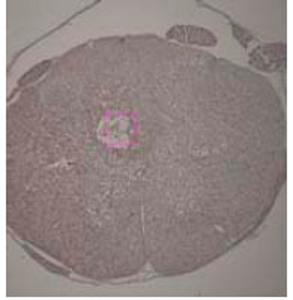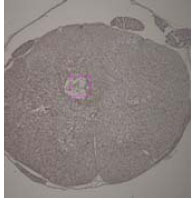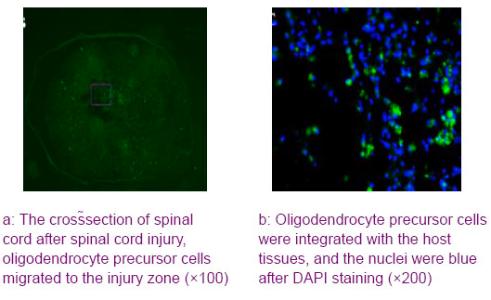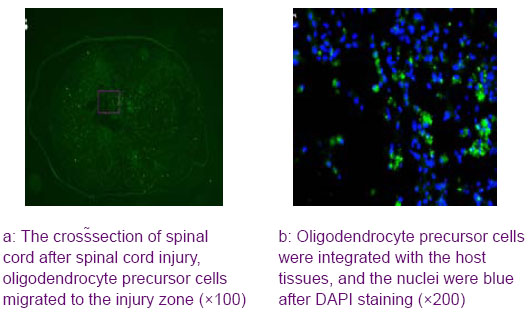Chinese Journal of Tissue Engineering Research ›› 2012, Vol. 16 ›› Issue (49): 9192-9195.doi: 10.3969/j.issn.2095-4344.2012.49.013
Previous Articles Next Articles
Histological changes of oligodendrocyte precursor cells for repair of spinal cord injury
Kong Jian1, Zhang Hong-nan2, Jia Dan3, Wang Duo3, Chen Ming-wei1, Xue Meng-meng2, Li Yan2, Fan Ye-wen2, Liu Xin1, Liu Sheng-liang3, Liu Jing-jing3, Ge Xiao-ping1, Jiang Zhe4, Wu Shu-liang1
- 1Department of Anatomy, Harbin Medical University, Harbin 150081, Heilongjiang Province, China; 2Heilongjiang University of Chinese Medicine, Harbin 150081, Heilongjiang Province, China; 3Affiliated Hospital of Harbin Medical University, Harbin 150081, Heilongjiang Province, China; 4Heilongjiang Nursing College, Harbin 150081, Heilongjiang Province, China
-
Received:2012-04-13Revised:2012-05-13Online:2012-12-02Published:2013-01-16 -
About author:Kong Jian, Lecturer, Department of Anatomy, Harbin Medical University, Harbin 150081, Heilongjiang Province, Chinasayyear@163.com -
Supported by:No.81073162*; National Postdoctoral Sustentation Fund, No.20100471023*
CLC Number:
Cite this article
Kong Jian, Zhang Hong-nan, Jia Dan, Wang Duo, Chen Ming-wei, Xue Meng-meng, Li Yan, Fan Ye-wen, Liu Xin, Liu Sheng-liang, Liu Jing-jing, Ge Xiao-ping, Jiang Zhe, Wu Shu-liang. Histological changes of oligodendrocyte precursor cells for repair of spinal cord injury[J]. Chinese Journal of Tissue Engineering Research, 2012, 16(49): 9192-9195.
share this article

2.1 实验动物数量分析 造模实验成功率为100%,纳入小鼠32只,均分为模型组、假手术组、治疗组和对照组,实验过程中无脱失,全部动物都进入结果分析。 2.2 脊髓损伤模型小鼠的行为学观察 模型组小鼠于术后1 h左右苏醒,醒后观察发现,双下肢呈瘫痪状态,运动功能完全丧失。头部、前肢运动功能正常,可以拖着后肢移动。而假手术组行动正常,无上述截瘫症状。 2.3 少突胶质前体细胞的增殖与分化 刚接种的少突胶质前体细胞呈圆形小亮点,折光性强,培养2 h后,细胞贴壁生长,呈现出具有双极突起的典型少突胶质前体细胞形态。免疫荧光检测发现细胞呈A2B5阳性表达。随着培养时间增加,细胞不断增殖且逐渐相互连接,细胞突起增多。加入含有体积分数10%胎牛血清,48 h后即发现细胞开始伸出多个突起,少突胶质前体细胞分化形成少突胶质细胞,见图1。"
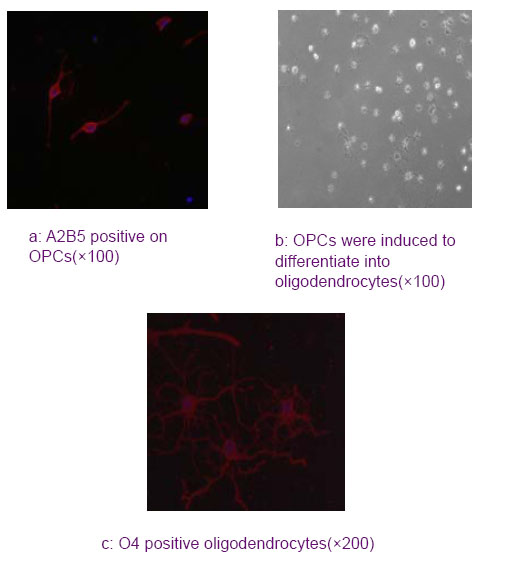
| [1] Kohout RK, Saunders LL, Krause JS. The relationship between prescription medication use and ability to ambulate distances after spinal cord injury. Arch Phys Med Rehabil. 2011;92(8):1246-1249.[2] Gorzkowski J, Kelly EH, Klaas SJ, et al. Obstacles to community participation among youth with spinal cord injury.J Spinal Cord Med. 2011;34(6):576-585. [3] Tu?cu I, Tok F, Y?lmaz B, et al. Epidemiologic data of the patients with spinal cord injury: seven years' experience of a single center. Ulus Travma Acil Cerrahi Derg. 2011;17(6): 533-538.[4] Lee JH, Chung WH, Kang EH, et al. Schwann cell-like remyelination following transplantation of human umbilical cord blood (hUCB)-derived mesenchymal stem cells in dogs with acute spinal cord injury.J Neurol Sci. 2011;300(1-2): 86-96. [5] Ward RE, Huang W, Curran OE, et al. Docosahexaenoic acid prevents white matter damage after spinal cord injury.J Neurotrauma. 2010;27(10):1769-1780.[6] Faulkner J, Keirstead HS. Human embryonic stem cell-derived oligodendrocyte progenitors for the treatment of spinal cord injury. Transpl Immunol. 2005;15(2):131-142.[7] Tian B, Liu HW, Wu SL, et al. Zhongguo Linchuang Kangfu. 2003;9(25):3430-3431.田波,刘慧雯,吴树亮,等.大鼠胎脑神经细胞与胶原复合体移植对脑损伤的修复[J].中国临床康复,2003,9(25):3430-3431.[8] Mekhail M, Almazan G, Tabrizian M. Oligodendrocyte-protection and remyelination post-spinal cord injuries: a review.Prog Neurobiol. 2012;96(3):322-339. [9] Lü HZ, Wang YX, Zhou JS, et al. Cyclosporin A increases recovery after spinal cord injury but does not improve myelination by oligodendrocyte progenitor cell transplantation. BMC Neurosci. 2010;11:127.[10] Allen AR.Surgery of experimental lesion of spinal cord equivalent to crush injury of facture dislocatoon od spinal colum.JAMA. l911;57:878-880.[11] Basso DM, Beattie MS, Bresnahan JC. A sensitive and reliable locomotor rating scale for open field testing in rats. J Neurotrauma. 1995;12(1):1-21.[12] Baumann N, Pham-Dinh D. Biology of oligodendrocyte and myelin in the mammalian central nervous system. Physiol Rev. 2001;81(2):871-927.[13] Siebert JR, Stelzner DJ, Osterhout DJ. Chondroitinase treatment following spinal contusion injury increases migration of oligodendrocyte progenitor cells. Exp Neurol. 2011;231(1):19-29.[14] Lü HZ, Wang YX, Zou J, et al. Differentiation of neural precursor cell-derived oligodendrocyte progenitor cells following transplantation into normal and injured spinal cords.Differentiation. 2010;80(4-5):228-240.[15] Cao Q, He Q, Wang Y, et al. Transplantation of ciliary neurotrophic factor-expressing adult oligodendrocyte precursor cells promotes remyelination and functional recovery after spinal cord injury.J Neurosci. 2010;30(8): 2989-3001.[16] Lytle JM, Chittajallu R, Wrathall JR, et al. NG2 cell response in the CNP-EGFP mouse after contusive spinal cord injury. Glia. 2009;57(3):270-285.[17] Mayer-Proschel M, Kalyani AJ, Mujtaba T, et al. Isolation of lineage-restricted neuronal precursors from multipotent neuroepithelial stem cells. Neuron. 1997;19(4):773-785.[18] Kerr CL, Letzen BS, Hill CM, et al. Efficient differentiation of human embryonic stem cells into oligodendrocyte progenitors for application in a rat contusion model of spinal cord injury.Int J Neurosci. 2010;120(4):305-313.[19] Saxena T, Gilbert JL, Stelzner D, et al. Mechanical Characterization of the Injured Spinal Cord Following Lateral Spinal Hemisection Injury in the Rat. J Neurotrauma. 2012 Mar 21.[20] Lee SM, Yune TY, Kim SJ, et al. Minocycline reduces cell death and improves functional recovery after traumatic spinal cord injury in the rat. J Neurotrauma. 2003;20(10):1017-1027. |
| [1] | Lyu Ruyue, Gu Lulu, Liu Qian, Zhou Siyi, Li Beibei, Xue Letian, Sun Peng. Regulatory mechanisms of exosome secretion and its application prospects in biomedicine [J]. Chinese Journal of Tissue Engineering Research, 2026, 30(1): 184-193. |
| [2] | Xu Canli, He Wenxing, Wang Yuping, Ba Yinying, Chi Li, Wang Wenjuan, Wang Jiajia. Research context and trend of TBK1 in autoimmunity, signaling pathways, gene expression, tumor prevention and treatment [J]. Chinese Journal of Tissue Engineering Research, 2026, 30(在线): 1-11. |
| [3] | Liu Xun, Ouyang Hougan, Pan Rongbin, Wang Zi, Yang Fen, Tian Jiaxuan . Optimal parameters for physical interventions in bone marrow mesenchymal stem cell differentiation [J]. Chinese Journal of Tissue Engineering Research, 2025, 29(31): 6727-6732. |
| [4] | Hu Enxi, He Wenying, Tao Xiang, Du Peijing, Wang Libin. Regulation of THZ1, an inhibitor of cyclin-dependent kinase 7, on stemness of glioma stem cells and its mechanism [J]. Chinese Journal of Tissue Engineering Research, 2025, 29(25): 5374-5381. |
| [5] | Lin Meiyu, Zhao Xilong, Gao Jing, Zhao Jing, Ruan Guangping. Action mechanism and progress of stem cells against ovarian granulosa cell senescence [J]. Chinese Journal of Tissue Engineering Research, 2025, 29(25): 5414-5421. |
| [6] | Tian Zhenli, Zhang Xiaoxu, Fang Xingyan, Xie Tingting. Effects of sodium arsenite on lipid metabolism in human hepatocytes and regulatory factors [J]. Chinese Journal of Tissue Engineering Research, 2025, 29(23): 4956-4964. |
| [7] | Han Fang, Shu Qing, Jia Shaohui, Tian Jun. Electrotactic migration and mechanisms of stem cells [J]. Chinese Journal of Tissue Engineering Research, 2025, 29(23): 4984-4992. |
| [8] | Hu Chen, Jiang Ying, Chen Jia, Qiao Guangwei, Dong Wen, Ma Jian. Preparation and characterization of alendronate/chitosan/polyvinyl alcohol composite hydrogel films [J]. Chinese Journal of Tissue Engineering Research, 2025, 29(22): 4720-4730. |
| [9] | Yang Chao, Luo Zongping. Small molecule drug TD-198946 enhances osteogenic differentiation of rat bone marrow mesenchymal stem cells [J]. Chinese Journal of Tissue Engineering Research, 2025, 29(13): 2648-2654. |
| [10] | Li Xiaofeng, Zhao Duo, Ouyang Qin, Pang Zixiang, Li Yuquan, Chen Qianfen. Protective effect of mangiferin on oxidative stress injury in rat bone marrow mesenchymal stem cells [J]. Chinese Journal of Tissue Engineering Research, 2025, 29(13): 2669-2674. |
| [11] | Hu Zezun, Yang Fanlei, Xu Hao, Luo Zongping. Effect of surface roughness of polydimethylsiloxane on osteogenic differentiation of bone marrow mesenchymal stem cells under stretching conditions [J]. Chinese Journal of Tissue Engineering Research, 2025, 29(10): 1981-1989. |
| [12] | Yang Zhihang, Sun Zuyan, Huang Wenliang, Wan Yu, Chen Shida, Deng Jiang. Nerve growth factor promotes chondrogenic differentiation and inhibits hypertrophic differentiation of rabbit bone marrow mesenchymal stem cells [J]. Chinese Journal of Tissue Engineering Research, 2025, 29(7): 1336-1342. |
| [13] | Huang Ting, Zheng Xiaohan, Zhong Yuanji, Wei Yanzhao, Wei Xufang, Cao Xudong, Feng Xiaoli, Zhao Zhenqiang. Effects of macrophage migration inhibitory factor on survival, proliferation, and differentiation of human embryonic stem cells [J]. Chinese Journal of Tissue Engineering Research, 2025, 29(7): 1380-1387. |
| [14] | Liu Haowen, Qiao Weiping, Meng Zhicheng, Li Kaijie, Han Xuan, Shi Pengbo. Regulation of osteogenic effects by bone morphogenetic protein/Wnt signaling pathway: revealing molecular mechanisms of bone formation and remodeling [J]. Chinese Journal of Tissue Engineering Research, 2025, 29(3): 563-571. |
| [15] | Zhou Shijie, Li Muzhe, Yun Li, Zhang Tianchi, Niu Yuanyuan, Zhu Yihua, Zhou Qinfeng, Guo Yang, Ma Yong, Wang Lining. Effect of Wenshen Tongluo Zhitong formula on mouse H-type bone microvascular endothelial cell/bone marrow mesenchymal stem cell co-culture system [J]. Chinese Journal of Tissue Engineering Research, 2025, 29(1): 8-15. |
| Viewed | ||||||
|
Full text |
|
|||||
|
Abstract |
|
|||||
